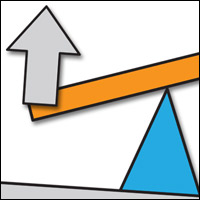Levers are an essential part of many mechanisms. They can be used to change the amount, the strength and the direction of movement.
The position of the force and the load are interchangeable and by moving them to different points on the lever, different effects can be produced. The fixed point of the lever about which it moves is known as the fulcrum. In this example the force and the load move in opposite directions. With the force three times closer to the fulcrum them the load lifted is only one third of the force but it moves three times as far.
First order lever. Like a see-saw or balance, the load and the force are separated by the fulcrum. As one moves up the other moves down. The amount and the strength of the movement is proportional to the distance from the fulcrum
Second order lever. A wheel barrow is a second order lever. Here the load is between the force and the fulcrum.
This uses mechanical advantage to ease lifting of a large weight.
Third order lever.
Here the force is between the fulcrum and the load. Mechanical advantage is reduced but the movement at the load point is increased.


